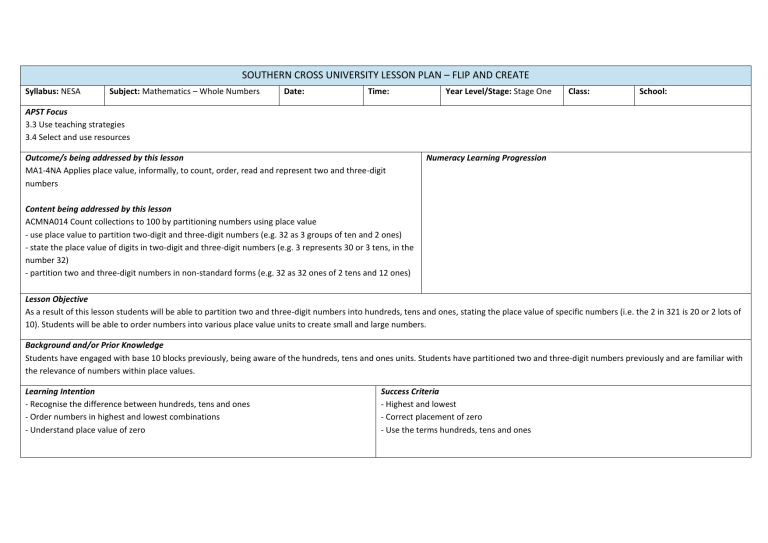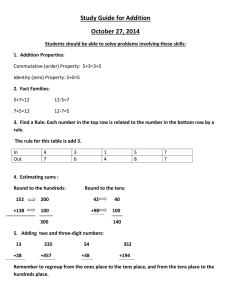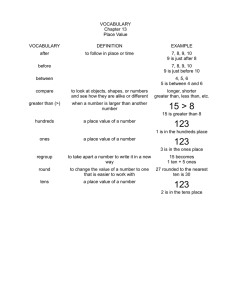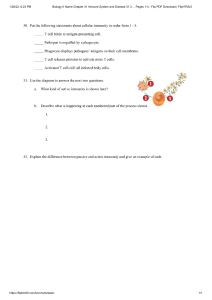
SOUTHERN CROSS UNIVERSITY LESSON PLAN – FLIP AND CREATE Syllabus: NESA Subject: Mathematics – Whole Numbers Date: Time: Year Level/Stage: Stage One Class: School: APST Focus 3.3 Use teaching strategies 3.4 Select and use resources Outcome/s being addressed by this lesson MA1-4NA Applies place value, informally, to count, order, read and represent two and three-digit numbers Numeracy Learning Progression Content being addressed by this lesson ACMNA014 Count collections to 100 by partitioning numbers using place value - use place value to partition two-digit and three-digit numbers (e.g. 32 as 3 groups of ten and 2 ones) - state the place value of digits in two-digit and three-digit numbers (e.g. 3 represents 30 or 3 tens, in the number 32) - partition two and three-digit numbers in non-standard forms (e.g. 32 as 32 ones of 2 tens and 12 ones) Lesson Objective As a result of this lesson students will be able to partition two and three-digit numbers into hundreds, tens and ones, stating the place value of specific numbers (i.e. the 2 in 321 is 20 or 2 lots of 10). Students will be able to order numbers into various place value units to create small and large numbers. Background and/or Prior Knowledge Students have engaged with base 10 blocks previously, being aware of the hundreds, tens and ones units. Students have partitioned two and three-digit numbers previously and are familiar with the relevance of numbers within place values. Learning Intention - Recognise the difference between hundreds, tens and ones - Order numbers in highest and lowest combinations - Understand place value of zero Success Criteria - Highest and lowest - Correct placement of zero - Use the terms hundreds, tens and ones SOUTHERN CROSS UNIVERSITY LESSON PLAN – FLIP AND CREATE Timing Allow 5 minutes to introduce the lesson Procedure Orientation 1. Introduce the ‘Flip and Create’ sheet 2. Explain the activity Considerations Room Layout - Students sitting on floor on their designated dots Organisation - Display the ‘Flip and Create’ sheet on the board Resources - ‘Flip and Create’ sheet (see appendices) HOT Questions - What do you notice about the ‘Flip and Create’ sheet - What do we know about place value? - What do you think we might be doing? Guided Discovery 1. Demonstrate the example, flipping over pre-chosen cards and arranging them into highest combination 2. Lowest combination (student input) 3. Record your answers on the sheet 4. Confirm students have a clear understanding of the task (see LOT Questions) Equipment - Whiteboard - Marker - Printed ‘Flip and Create’ sheet (see appendices) - Playing cards (0 – 9) Organisation - Pick out the same cards used as an example on the sheet (7, 2, 4) - Hand out sheets and playing cards as students return to desks HOT Questions - How do we know the 7 means 700, 2 means 20? - How could we rearrange these numbers to make the highest/lowest number? Exploration 1. Working individually/in pairs 2. Students flip numbered cards (1 – 9) 3. Students organise cards into highest and lowest numbers, using Equipment - A pencil Resources - ‘Flip and Create’ sheet (see appendices) HOT Questions - How do you know that is the highest/lowest number? LOT Questions “Working in pairs, you will flip over three playing cards. You will then order them in the place value section, to create the highest number possible, and the lowest number possible. You must record your answers on your sheet” 3. Talk about place value columns (demonstrate example) 4. Swap the last number to the front to show the difference of place value Allow 5 minutes to model the activity Allow 20 minutes for the Assessment LOT Questions - If I put a 6 in the hundreds column what would that represent? LOT Questions - How many cards do I need to turn over? - Am I going to put the cards in any order in my highest/lowest column? - Can you put 2 cards in a place value column? Exploration activity the place value columns as a guide 4. Students record their cards and created numbers on the sheet 5. Assess students during Exploration (see assessment sheet) - Playing cards (0 – 9) Room Layout - Students back at desks, working individually or in pairs - Walking around the room, assess individuals - What numbers/cards are you working with? - What number is in the hundreds/tens/ones column? - What is the highest/lowest number you can make with your numbers/cards? Allow 10 minutes for the Reflection of the lesson Reflection 1. Highlight common mistakes (from assessment notes) Room Layout - Students back on their designated dots Organisation - Stand out front, near whiteboard to record answers HOT Questions - What made it easy/what was tricky - Did you notice any patterns? LOT Questions - Is that correct? - What cards did you draw? - What was the high/low number you made? 2. Discuss process and answers (see HOT and LOT Questions) 3. Ask for student examples (highest and lowest number) Notes Differentiation Above + Thousands Below - Tens and ones with MAB blocks Flip and Create Flip over three cards and rearrange them to make the SMALLEST and LARGEST number Hundreds Tens Ones Fill in the sheet as you go! Cards Highest Lowest




